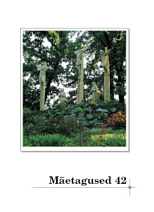Mõiste giš-hur tähendusest sumeri ja akkadi kirjanduslikes ja rituaaltekstides
Interpreting the Concept of ‘Plan’ in Sumerian and Akkadian Literary and Ritual Texts
Author(s): Liina Ootsing-LüeckeSubject(s): Christian Theology and Religion
Published by: Eesti Kirjandusmuuseum
Keywords: Akkadian; Assyriology; history of religion; mythology; religious phenomenology; Sumerian
Summary/Abstract: The aim of this article is to interpret the meaning and concept of the word ‘plan’ or ‘drawing’ in Sumerian and Akkadian written sources and to give a brief summary of this phenomenon in Mesopotamia in the 3rd-1st millennium BC. The Sumerian word giš-hur (lit. ‘wood scratch’, meaning ‘plan’ or ‘design’), and the Akkadian word esRru(m) (‘to draw’, ‘to design’, ‘drawing’, ‘design’ or ‘plan’) are mostly mentioned in a substantive context which encompasses the divine sphere. Gods and kings establish the world order with various ‘designs’ and ‘plans’. The Sumerian phenomenon of me (the ‘divine power’ of gods) which describes god’s essence and is a divine attribute, and the Akkadian term parsu(m) (‘cultic ordinance’) which encompasses divine ‘order’ and ‘cultic rites’, are both closely connected with the phenomena of giš-hur and esRru(m). In Sumerian and Akkadian myths and epics, the phrases ‘the plan of heaven and earth’ and ‘the cosmic order’ refer to the actions of gods and kings who always plan or design something substantial. A ‘plan’ is a means of securing power for a king. Gods also have ‘plans’ and ‘designs’ and deliver them to kings in an effort to strengthen and guarantee their reign. Kings have a duty to fulfil the ‘plan’ or ‘regulations’ of the land or kingdom. In Sumerian mythology the phenomenon of giš-hur is connected with the underground aquifer abzu and its master, the god Enki. This understanding is also reflected in the late Babylonian epic of creation, which describes the establishing and securing the universal order. Sumerians and Akkadians also ‘designed’ and ‘drew’ many ‘temple’, ‘town’ and ‘kingdom’ plans, which had only local importance, but the loss of these plans is grieved about in several lamentation compositions. In later bilingual texts, abstract ‘cosmic’ and ‘life’ designs are mentioned. In Babylonian and Assyrian myths the creation of people is described as ‘drawing their shape’, and the same phrase is used in regard to the creation of other creatures and things. In Akkadian mythology the terms ‘plan’ and ‘design’ very often seem to be synonymous with parsu(m) (‘cultic ordinance’), which is administered by gods and kings. It can be lost in struggles for power and can therefore cause cosmic disorder and imbalance. In Sumerian and Akkadian incantations, primarily in apotropaic rites, the terms ‘magic circle’ or ‘drawing’ or ‘line’ describe a boundary that demons cannot cross. These ceremonial rites probably have a broader meaning: to avoid demons’ interference in the cosmic order which is under the control and patronage of gods. They set up ‘nets’ and ‘traps’ for evil ghosts who have crossed the magic border. The crafty god Enki/Ea mostly draws the magic circle: this phenomenon may be connected with the Sumerian perception about this god as a designer of temple plans.
Journal: Mäetagused. Hüperajakiri
- Issue Year: 2009
- Issue No: 42
- Page Range: 123-148
- Page Count: 26
- Language: Estonian

